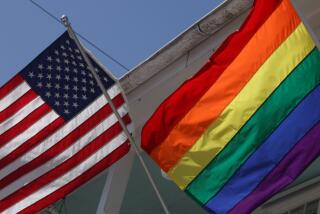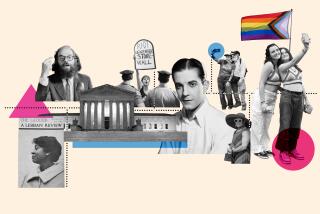Data on AIDS May Suggest Resurgence
- Share via
WASHINGTON — On the eve of the 20th anniversary of the first reported cases of AIDS, federal health officials released disturbing new evidence Thursday that infections may be rising in a second generation of young gay men who were not even out of childhood when the epidemic began.
In a study of six cities, including Los Angeles, the Centers for Disease Control and Prevention found a 4.4% annual rate of new infections in gay men ages 23 to 29, a sign that downward trends may be reversing.
During the height of the acquired immune deficiency syndrome epidemic in the early 1980s, infection rates among gay men skyrocketed to as high as 20%. They then dropped in the ensuing years to as low as 2% by 1985 and remained stable until recently, thanks in part to the mobilization efforts of the gay community to educate their own.
Drawing on data from the same six-city study, the disease centers reported in February that one in 10 young gay and bisexual men was infected with HIV, the AIDS virus. The proportion climbed to 30% among African Americans in the same group.
By pinpointing how recently an infection occurred, the latest findings indicate a new wave of increasing cases among gay men. Of every 100 gay men uninfected at the beginning of the year, four will be infected by year’s end if the statistics hold. Even more alarming, African American gay men had a 14.7% rate, compared with 3.5% among Latino gays and 2.5% for white gays.
“We are damned by our own successes,” said Phill Wilson, director of the African American AIDS Policy and Training Institute in Los Angeles. People no longer regard AIDS as an automatic death sentence, he said, adding: “All these posters that say you can climb mountains with AIDS. People feel it isn’t too bad--until they get infected.”
Experts say many young gay men have become complacent, a result of powerful new drugs that are keeping AIDS-infected individuals alive longer, and “they don’t see the dying--the same fear--as 20 years ago,” said Dr. Martha Rogers, a CDC official who has tracked the epidemic since its start. “These people have the sense that it’s not so bad to have HIV--they were babies 20 years ago.”
The new findings were released by the CDC to mark the beginning of the third decade of the epidemic.
Since the first cluster of cases was reported June 5, 1981, among gays in Los Angeles and New York, 774,467 Americans have been diagnosed with AIDS and 450,000 have died. Almost 22 million people worldwide have died.
In this country, there are about 40,000 new infections annually--a number that has remained stable since the early 1990s after it peaked at 150,000 in the mid-1980s. Infections have lessened somewhat in certain populations, including intravenous drug users and among babies born to infected mothers.
The first CDC report 20 years ago noted a mysterious outbreak of illness among gay men in Los Angeles and New York. In Los Angeles, there were five inexplicable cases of a kind of pneumonia until then seen only in those with severely compromised immune systems, such as transplant recipients. In New York, 26 gay men had developed Kaposi’s sarcoma, a rare cancer of the capillaries that characteristically appears as dark bruise-like lesions on the skin. Until then, this cancer had been virtually nonexistent in the United States.
There was no sign that this small cluster of cases would explode into the world with deadly consequences, bringing with it indelible political and social ramifications.
The AIDS epidemic not only challenged the nation’s health care system, its biomedical researchers and policymakers, but also forced Americans to confront their own basic attitudes about sex, especially homosexuality, drug use and how they would respond to a deadly, infectious and incurable illness that at first was striking only those largely regarded as societal outcasts.
The study involved 2,942 gay men in Los Angeles, Baltimore, Dallas, Miami, New York City and Seattle, using a special test developed by the CDC that can show when an infection occurred. Of these, 373 were infected, and 290 of them were recent infections. The CDC did not have separate data available for Los Angeles or any of the other cities.
The findings followed the CDC’s February report that described a high prevalence--that is, the total number--of infections within this same group of gay men, said Dr. Linda Valleroy, the CDC official who conducted the study.
The CDC then used its testing technology to determine how recently the men had become infected to calculate the rate of new infections.
“This is a strong and troubling indicator that the HIV epidemic will continue to expand in that group,” she said.
She added that, especially among black gay men, “these are explosive HIV incidence rates.”
Taken with an earlier CDC seven-city study of adolescent gay men ages 15 to 22 that looked at the number of total infections and their rate of new infections, the findings indicate that the incidence of new infections increased “substantially” between adolescence and the early 20s, “underscoring the need to reach each generation of at-risk [gay men] early,” the CDC said.
CDC officials stressed that the sample size of the most recent study was small; nevertheless, the study documents “the dramatic impact HIV is having among gay and bisexual men of all races, and the urgent need to expand our prevention efforts . . . particularly in African American communities,” said Dr. Helene Gayle, director of the CDC’s national center for HIV, sexually transmitted disease and tuberculosis prevention.
The CDC spends about $400 million a year to fund state and local HIV prevention programs; within that, the agency has earmarked $12 million in direct funding this year for community-based programs targeted toward gay men and $3 million for national and regional organizations for training community groups to work with African American gay men at risk.






